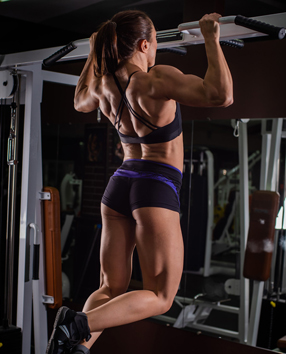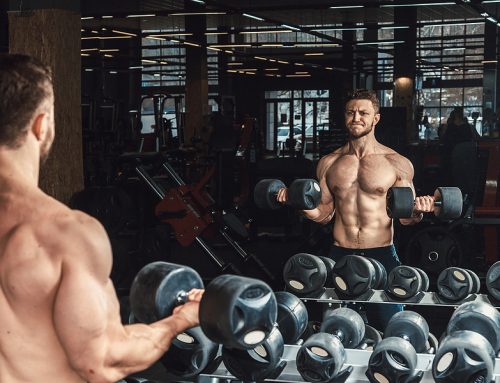Wanna know how to get your first pull-up – and then quickly build up to full sets of 10 or more? If so, you’re in the right place! Most beginners and even a large number of experienced lifters still struggle to do their first unassisted (“real”) pull-up. Pull-ups are hard! Whether you’re a man or a woman, whether you can’t do a single rep yet, or you want to increase your reps, right here in today’s post you will learn the most effective and proven training tricks to go from zero pull-ups to your first pull-up. And then, full sets of pull ups…
 1. DO NEGATIVE (SELF-ASSISTED) PULL-UPS
1. DO NEGATIVE (SELF-ASSISTED) PULL-UPS
This is the #1 technique I used when I was a beginner (and couldn’t pull myself up once), to quickly get my first pull up… then do 3, 6, 8, 10, 12, 15… 20… And ultimately, I hit a personal record of 30 reps a few years ago (just shy of age 50)… clean “military” reps (none of that kipping stuff!)
To do a self-assisted, aka negative pull up, put a step stool or bench underneath the pull-up bar, slightly in front of you. Grab the bar firmly with both hands slightly wider than shoulder width apart. Put your foot on the stool, and using the strength of your leg, kick yourself up over the bar (kind of like doing the step up exercise). Then, lower yourself slowly, or at least resist the negative.
Why does this work? Because your lowering (eccentric) or “negative” strength is greater than your lifting (concentric) strength. In other words, you will have the strength to lower yourself sooner than you’ll have the strength to lift yourself unassisted.
As your eccentric strength increases, so does your overall strength, and then suddenly, one day, you don’t have to kick yourself up for that first rep!
Best part: You can keep using negative reps to continue building your rep count. Once you can pull yourself up once, then kick yourself up for rep two. Repeat the process until you’re doing all the reps you want to do!
If you’re struggling even to lower yourself, what then? Don’t sweat it – there are other tactics you can use to help you get your first pull-up (see below). But at least try to control yourself on the way down. You may not be able to lower yourself slowly, but resist gravity the best you can. Negative strength improves quickly, but not if you don’t at least keep trying.
2. GET A PARTNER FOR ASSISTED NEGATIVE REPS
If you have a training partner, you can do partner-assisted negative reps, which work the same way as self-assisted negatives. The difference is, instead of using your foot to kick yourself up from a stool or bench, your partner spots you.
One way is your partner uses both hands to grab the sides of your waist and help you up, then release to allow you to lower yourself down slowly.
Another way is you can cross your feet at your ankles and your partner can grab under your feet or ankles and lift you up, and / or you can simultaneously kick up off your partner’s hands to give yourself the exact amount of assistance you want.
The partner-assisted method is ideal because a good spotter can give you just the right amount of assistance to complete each rep. Do this for a short while and soon you’ll get your first pull-up, completely unassisted.
3. COUNT YOUR ACCUMULATED REPS
A set is a certain number of repetitions all in a row (continuous). Most of the time, you do sets of 8 to 12 reps or so, give or take a few either way. However, when you’re in the building-up stage of getting better at pull-ups, I recommend you shift your mentality from the traditional approach to focusing on the total reps you accumulate.
I had a reader tell me the other day he was happy to finally hit his first unassisted rep, but it was still only 1 rep. I said, “How many did you do in total?” He said, “Only 1, that’s all I can do so far.” I replied,”Okay, great job, great start. Next time I want you to do 2, and the workout after that 3 and the workout after that 4 and keep going.”
He said, “It barely got my first single rep and it took me forever! I don’t think I can add a rep every workout.” I said, “Sure you can! Even if you don’t get two in a row yet, you can do multiple sets of one,” I explained…”
“Do your single rep. Then take a one or two minute rest break. Then do it again. That’s two sets of one – progression achieved! Next time, if you still can only do one at a time, do three sets of one. That’s three total accumulated reps. By then, maybe you’ll get two reps in a row on your first set. Then rest, do another set of one or two, rest and do another set of one or two. Keep going with that system until you’re doing as many reps as you want.”
The key is to not get your mind trapped in a traditional concept of how many reps must be in a set and how many sets you’re supposed to be doing. If you want to do 10 reps, there’s no reason you can’t try 10 sets of 1 or 5 sets of 2, or any combination in between.
Plus you can do a mix of unassisted and assisted (negative) reps as well. So your total for a workout might be 4 unassisted and 6 assisted. Keep track of those rep numbers in your log and keep trying to beat it (progressive overload is key! Once you understand the concept of progressive overload and that it includes more reps, not just more weight, your gains go through the roof!)
This approach will motivate the heck out of you too because you can make progress every workout with this system even if you can still only do a rep or two in a row, and if you do this consistently, your unassisted reps will improve faster than you think.
4. SWITCH YOUR GRIP: TRY CHIN UPS
Simple tip: Try chin-ups instead of pull-ups. Most trainers consider using the pronated (palms away) grip the “pull-up” and the supinated grip (palms facing you, ie “curl grip”) the “chin-up.”
Because the supinated grip allows your biceps to assist more, most people find they can do more chin-ups than pull-ups, and often get their first chin-up before their first pull-up.
Unlike inverted rows, which may help with building up to your first pull-up, but aren’t the same movement pattern, the chin-up and pull-up are the same movement pattern (vertical pull). The only difference is the grip. So if you get to doing chin ups first, you’ll be doing pull-ups very soon after!
Neutral grip pull-ups are also an excellent variation – they tend to be easier on the joints (elbows) as well.
5. USE THE ASSISTED CHIN / DIP MACHINE
If there’s any reason you can’t or don’t want to do assisted negatives, or if even a single negative pull-up is still too difficult, the assisted chin / pull up machine is the next best thing. The machine-assisted pull-ups may not get you doing unassisted real pull-ups faster than assisted negatives (strategy #1 and #2 above), but it’s still the same movement pattern, working the same muscles.
These machines are found in almost every commercial gym today. Older models have a foot pedal you stand on, while most of the newer models have a pad you kneel on. The purpose for the foot or knee support is to connect you to a weight stack, which is where the assistance comes from.
But unlike most most machines, the amount of weight you select is the amount of weight the machine lifts for you – just like your training partner might lift up some of your weight while spotting you. If you weigh 200 pounds and you put 100 pounds on the machine, you are only lifting 100 pounds of your body weight – the machine is lifting the other 100 for you.
Then, from workout to workout you apply the progressive overload principle, but unlike most exercises, on the assisted machine, you work in reverse – you try to reduce the amount of weight: if you put the machine on 90 pounds, then you have to lift 110 pounds of your weight.
Work on that for a while and then before you know it, you’ll be ready for the pull up bar – at least for assisted reps.
6. TRY BAND ASSISTED PULL-UPS
What if you want to do assisted pull-ups, but you don’t have a training partner and you don’t have access to an assisted pull-up machine? As mentioned above, you can do self-assisted pull-ups with negatives using a chair or bench. But another option that some people prefer is the resistance band pull-up.
By fastening a heavy-duty resistance band to an overhead bar, you step onto the band and the tension at the bottom will lift part of your body weight for you.
Due to the type of resistance (elastic) and the accommodating resistance curve, band-assisted pull-ups will be easier at the bottom (where the band is stretched) and harder at the top (where the band is looser). An assisted pull-up machine will provide even resistance through the whole range of motion, but the band assisted pull-ups are still an excellent variation to help you build up your strength until you can get your first pull-up unassisted.
7. DO LAT PULLDOWNS (NO SHAME IN PULLDOWNS!)
The principle of specificity in training says that if you want to improve a lift or exercise, the best way is to practice that exercise. It’s a bit of a paradox in the case of pull-ups when many people can’t do the exercise at all at first, but as you’ve just learned, there are solutions. With assisted reps, it is possible to train the actual pull-up movement before you can even do one rep on your own.
If we agree with this principle, and if the lat pulldown machine is not a pull-up, then the lat pulldown is not the ideal way to get better at pull-ups. If you want to get better at pull-ups, the best way is to do pull-ups.
With that said, the lat pulldown is the same movement pattern, and the good news is that almost everyone can do this exercise. If you start with lat pulldowns, you will be building strength and gaining muscle in the same areas of the back that pull-ups build, and there’s no shame in starting your vertical pulling work on the pulldown machine.
In fact, there’s no reason to ditch the lat pulldown even after you are a pull-up beast. Pulldowns are still a great exercise for variety and you’ll usually get the best muscle growth by rotating exercises periodically.
Just remember, if you’re doing lat pulldowns expecting them to increase your pull-ups, you might be disappointed. Use them to start building strength in your upper body pulling muscles, then get on to the pull-up bar as soon as you can.
I hope you found these tips to get your first pull up and increase your reps valuable. I know they work, because this is how I did it – from zero – and I know these tips will work for you too.
If you’re looking for a complete pull-up training course, complete with months of workout routines, including videos, check out my review of The Pull-Up Solution Program. Highly recommended.
Train hard and Expect Success,
Tom Venuto, author of
Burn the Fat, Feed the Muscle (amzn.to/2IWxPl3)
Founder and CEO, Burn the Fat Inner Circle






I got to my first chin up by using a dip belt and adding weight. It might seem like a negative thing to do, but when I took off the 5 lb. weight, after a few weeks, voila, a chin up. My muscles had gotten use to struggling with an extra 5 lbs, and without that extra weight the muscles had a less difficult job to do. I can do 5 chins, with my shoulders up to touch the bar. I’m 70 years old, so I doubt that I can improve much on that, but I keep doing them.
Doing negatives with extra weight is simply taking the self assisted negative technique to the next level! Thanks for sharing your strategy ,and keep up the great work!
Tom Sage advice here Thank You!
….Also bodyweight Rows are a good adjunct! Place a barbell or Smith machine about knee high…..Then get under, heels extended, and row…
Something about bodyweight training that helps….stabilizer muscles and core are fired up, which are also used when doing the pull up.
absolutely – in fact we covered that (“bodyweight rows” aka inverted rows, in the last post:
https://www.burnthefatblog.com/pullups-are-awesome-but-what-if-you-cant-do-any.php
I can do chin ups, but still struggle with the pull up. I have now added a few negative pull up reps to my routine–and I can feel the burn! I also hang from the bar to reduce shoulder pain (I’m 50 years old). Great tip, and I sure appreciate your no-nonsense, natural approach to bodybuilding, Tom. Thanks
Great article.